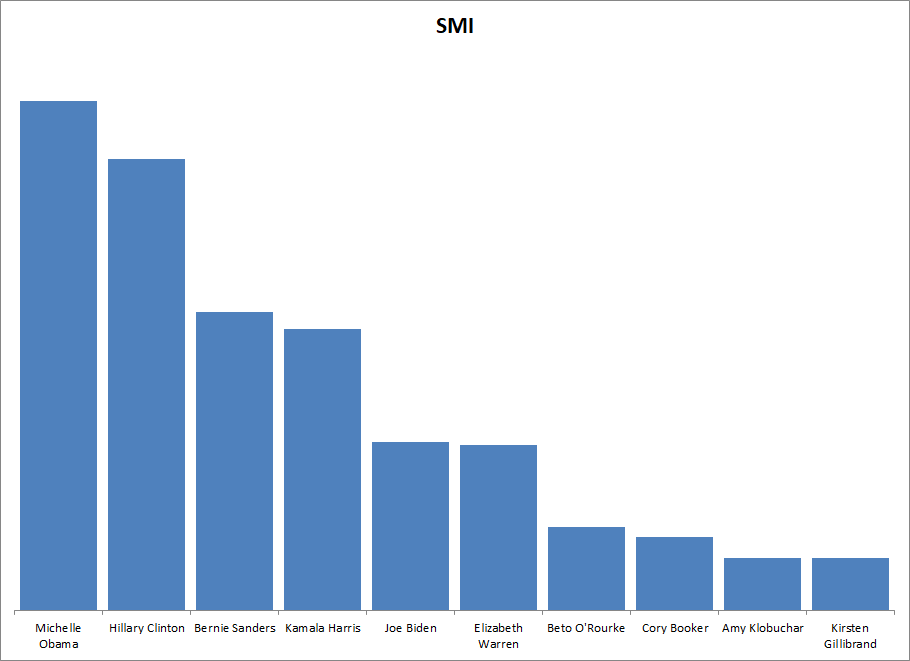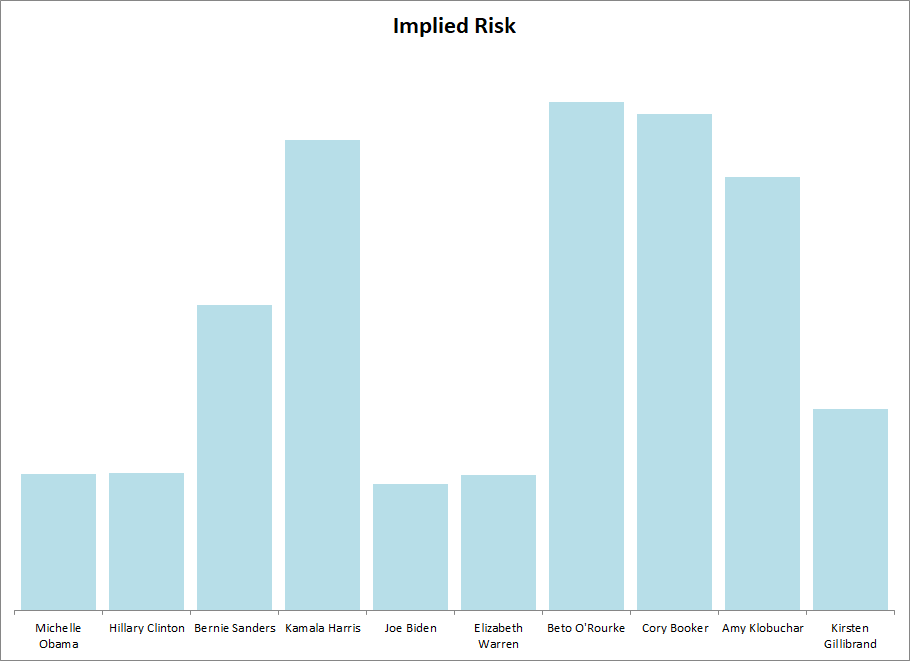Summary
Social Media Influence (SMI) highlights the continued strength of Michelle Obama and Hillary Clinton. It also shows the relative weakness of Joe Biden as well as the strength of Bernie Sanders in relation to Kamala Harris.
In addition to straightforward SMI analysis, we have added an Implied Risk metric which essentially measures a form of volatility of SMI for each of the potential candidates. It shows Michelle Obama, Hillary Clinton, Joe Biden, and Elizabeth Warren carrying lower risk. Kamala Harris and Bernie Sanders, two of the other primary candidates, post rather high Implied Risk.
All of the aforementioned SMI-based insights lend support to Michelle Obama being the most attractive potential candidate for the Democrats. We continue to see Michelle positioning herself as a reluctant savior for the Democratic Party, a theme we have explored in other reports and posts.
Social Media Influence (SMI) Trends
In some ways, SMI depicts similar trends to those shown by betting markets. For instance, as in the case of betting markets, SMI shows that Kamala Harris had been the front-runner of the consensus candidates (not including Michelle or Hillary) for much of January and February, with Bernie Sanders overtaking her just recently.
Perhaps more interesting than how SMI reflects other methods is how it differs. Joe Biden’s position looks rather weak according to SMI. His position would likely improve upon his announcement of running, as do most candidates. However, for a seemingly popular former VP who is leading in the polls, such a muted SMI seems discouraging to say the least. In fact, Biden’s SMI implies that he is a much weaker potential candidate than the consensus assumes.
SMI also shows that Michelle Obama would be the front-runner if she declares. The importance of her strong SMI should not be underestimated as SMI has been shown in multiple elections to be a leading indicator of poll trends. SMI implies that if she were to announce, she would zoom into a consensus front-runner status quickly while dwarfing the position of Bernie Sanders.
This last point is extremely important for those concerned over a splitting of the Democratic Party. Currently, with Bernie Sanders leading the presumed (actually declared plus consensus) candidates in betting markets and SMI and closing in on a poll lead, the potential for a rupture has increased. Establishment Democrats want to be secure that they have a strong candidate, who they feel can not only win the general election but also defeat Sanders. Michelle Obama would offer that almost immediately. She presumably would also be popular enough with the far-left of the Party as to prevent a rupture.
The current SMI ratings are presented in the following graph.
Figure 1: Social Media Influence (SMI) of Leading Democrats (March 9, 2019)
Source: ZettaCap
Interestingly, Michelle and Hillary have maintained the top two spots throughout 2019. In other words, even with a flurry of candidate declarations and PR blitzes of newly announced candidates, the two former FLOTUSes have remained firmly on top. This both highlights just how enduring they are as well as how potentially weak the thus-far candidates are, at least on social media.
After the top two spots, Bernie and Kamala are essentially tied. Bernie currently edges Kamala out, but this small advantage will likely disappear as the newness of his candidacy rubs off. Assuming Biden runs, we’d estimate that his SMI would jump to a similar level. Elizabeth Warren, having already announced and pushed to gain early traction, seems like a weak candidate given her current SMI.
The main point to take away from the SMI chart is that Michelle and Hillary still lead the pack. In addition, they have not benefited from the intense political interest created around the other candidates / potential candidates. They both exude influence which is a strong building block for any candidate and if either chose to run she would be the Democratic front-runner.
Implied Risk, a Social Media Based Indicator
We next wondered about risk of candidates in general. Traditional political analysis focuses on soft measures (is the candidate seasoned, have they been through a number of tough elections, have they been tested sufficiently, how do they perform with key demographics, how is performance in swing states, are they team players, etc.). We decided to create a quantitative risk measure based on our social media metrics to buttress traditional qualitative risk analysis.
Taking a page from financial market analysis, we took a look at how volatility measures could be applied to our social media based data. In finance, most assume the best performing asset with the lowest price volatility is the most attractive investment. We assume that for political candidates, a similar analysis can be done with SMI and our Implied Risk (volatility) measure. Essentially, you want a high SMI and low Implied Risk.
The following chart shows the candidates in the same order as the previous chart, with the highest SMI on the left and moving to the right in descending order, but with our Implied Risk or volatility measure shown in the chart.
Figure 2: Implied Risk of Candidacy, as measured by volatility of SMI (March 9, 2019)
Source: ZettaCap
The Implied Risk scores pass the common sense test. The four with extremely low Implied Risk are also the most well known individuals whose governing style if elected would be fairly easy to project. Interestingly, Biden has the lowest risk score which makes sense given his eight years as VP.
The four highest also make sense. Of the individuals on this list, those with the highest risk ratings are also those who have had the most limited national exposure.
Bernie Sanders is between these two groups. This again can be intuitively understood as he is well known having run in 2016 (reducing his perceived risk) but the most left-leaning of all the candidates making his expected governing style less predictable (increasing his perceived risk).
Together, SMI and Implied Risk provide seemingly fair and quantitative interpretation of the race at present.
For instance, Biden seems to be generally seen as an uninspiring candidate. The low level of excitement around his candidacy is generally seen as being offset by the fact that he is such a well known quantity with a steady hand (very low risk). This has been quantitatively shown using SMI and Implied Risk, both based 100% on social media data.
Michelle Obama posts the most impressive figures of the group with the highest SMI and the second lowest Implied Risk. According to social media based analysis, she is the best hope for the Democrats. With relative ease, she could influence the electorate on social media and do so from a position of trust and perceived low risk.

